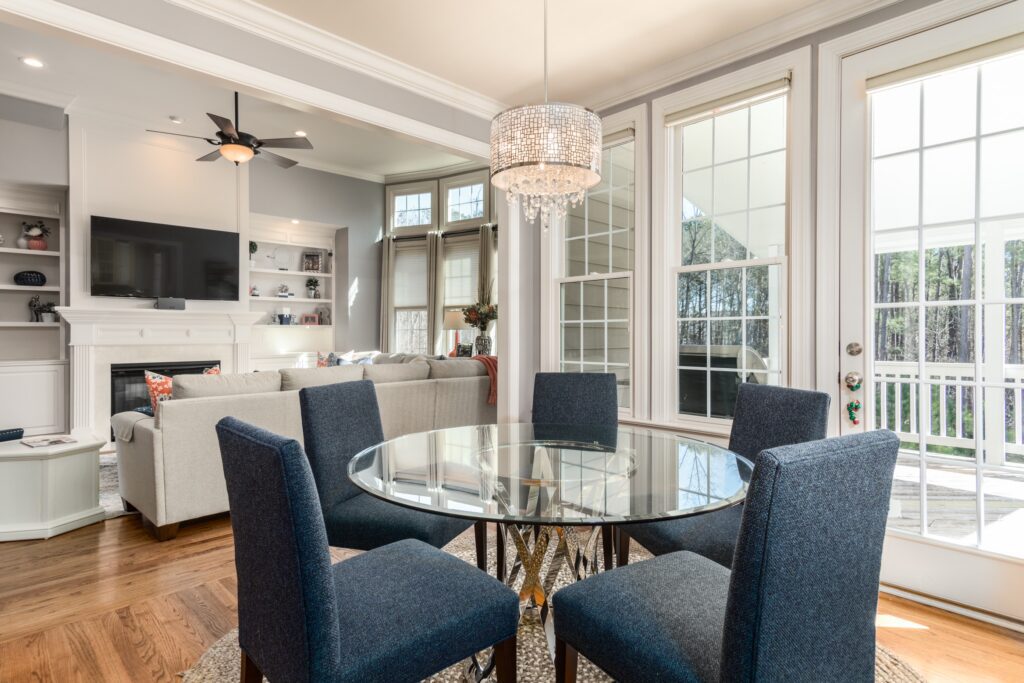Are you dreaming of owning a unique and affordable home? Look no further than building a shipping container home! With a limited budget, you can transform an old shipping container into a stylish and sustainable living space. In this article, we will explore the steps and tips to help you achieve your dream of building a shipping container home that fits your budget constraints. From finding the perfect container to designing and modifying the space, we’ve got you covered. Get ready to embark on an exciting journey of creating your own affordable and eco-friendly home.



This image is property of images.unsplash.com.
Understanding the Concept of Shipping Container Homes
Defining a shipping container home
A shipping container home is a type of dwelling that is constructed using repurposed shipping containers. These containers, typically made of steel, are designed to transport goods overseas. However, with some modifications and creative design, they can be transformed into comfortable and functional living spaces. Shipping container homes have gained popularity due to their unique and modern aesthetic, as well as their affordability and sustainability.
Benefits of shipping container homes
There are numerous benefits to opting for a shipping container home. Firstly, they are significantly more cost-effective compared to traditional housing options. The materials for building a shipping container home are affordable, especially when compared to the rising costs of building materials in the housing market. Additionally, the construction process is generally faster, saving both time and money.
Shipping container homes are also environmentally friendly. By repurposing shipping containers, you are reducing the amount of waste and contributing to the recycling and sustainability movement. Furthermore, shipping containers are highly durable and resistant to extreme weather conditions, making them a reliable and resilient housing option.
Another advantage of shipping container homes is their versatility. These homes can be customized to fit various design preferences and requirements. They can be stacked, combined, or modified to create larger living spaces, and their modular nature allows for easy expansion or relocation if needed.
Potential challenges associated with shipping container homes
While shipping container homes offer many benefits, it is important to recognize some potential challenges. One common concern is the limited space these homes provide, especially if using a single container. Adequate planning and thoughtful design are crucial to maximize the available space and ensure a comfortable living environment.
Insulation can also be a challenge in shipping container homes. The steel structure of the containers tends to retain and radiate heat, resulting in temperature fluctuations. Proper insulation and ventilation systems must be incorporated during the design and construction process to mitigate this issue.
Moreover, finding suitable land and navigating local building codes and regulations can be challenging. Depending on your location, there may be restrictions on where you can place a shipping container home and what modifications are allowed. It is essential to research and comply with these regulations to avoid any legal issues or delays.
Finding the Right Shipping Container
Choosing the size and type of container
One of the first considerations when building a shipping container home is selecting the appropriate size and type of container. Shipping containers come in various dimensions, with the most common sizes being 20 feet and 40 feet in length. The size you choose will depend on the design and layout of your home, as well as your specific needs and budget.
In addition to size, it is important to consider the type of container. The two main types are standard dry containers and high cube containers. Standard dry containers have a height of 8 feet 6 inches, while high cube containers provide an additional foot of height, offering more vertical space.
Where to purchase a shipping container
There are several options for purchasing shipping containers. One option is to buy directly from shipping container manufacturers or suppliers. They can provide both new and used containers, allowing you to choose based on your budget and preferences. Online marketplaces and local classifieds are also great places to look for used shipping containers at a potentially lower cost.
Understanding shipping container grades and conditions
When purchasing a used shipping container, it is crucial to understand the grading system. Shipping containers are graded based on their condition, with grades ranging from A (excellent condition) to D (poor condition). Grade A containers are typically newer and have minimal damage or wear, while Grade D containers may have significant structural issues or damage. It is important to carefully inspect the containers before purchase to ensure they meet your requirements and are in suitable condition for conversion.
Considerations for used containers
While used containers can be a cost-effective choice, it is important to consider any potential issues they may have. Look out for signs of rust, dents, or corrosion, as these can affect the structural integrity of the container. Additionally, consider the previous usage of the container, as some may have been exposed to hazardous materials. A thorough inspection and cleaning of the container is necessary to ensure it is safe for habitation.



This image is property of images.unsplash.com.
Designing your Shipping Container Home
Formulating a floor plan
Creating a well-thought-out floor plan is essential for maximizing the available space in your shipping container home. Start by determining the number of rooms and their respective sizes based on your needs. Consider factors such as privacy, functionality, and the flow of movement within the space. Sketch out a rough floor plan that includes areas for living, sleeping, dining, and any additional rooms or features you desire.
Considering space utilization
Space utilization is crucial in a shipping container home due to the limited area. Consider utilizing multi-functional furniture and built-in storage to make the most of every square foot. Look for clever space-saving solutions, such as foldable tables and beds, sliding doors, and wall-mounted storage units. Utilize vertical space by incorporating loft areas or storage racks.
Incorporating natural light and ventilation
To create a comfortable living environment, it is important to incorporate natural light and ventilation into your shipping container home design. Consider placing windows strategically to maximize sunlight and provide views of the surroundings. Skylights and glass doors can also enhance the sense of openness and connection with the outdoors. Additionally, plan for adequate ventilation by incorporating vents or fans to promote air circulation.
Planning for insulation
Insulation is key to maintaining a comfortable and energy-efficient shipping container home. Proper insulation helps regulate temperature, prevent condensation, and reduce energy consumption. There are various insulation options available, such as spray foam insulation, rigid foam boards, or fiberglass insulation. Research the most suitable insulation materials for your climate and ensure they are properly installed to achieve optimal insulation performance.
Acquiring Necessary Permits
Understanding local building codes and regulations
Before beginning construction on your shipping container home, it is essential to familiarize yourself with local building codes and regulations. These codes dictate the requirements and standards for safety, structural integrity, electrical systems, plumbing, and various other aspects of construction. Research the specific codes and regulations for your area, as they can vary greatly depending on your location.
Obtaining construction permits
Once you have a clear understanding of the local building codes, obtain the necessary construction permits before starting any work. Permits ensure that your project meets safety standards and is in compliance with the law. The application process may involve submitting detailed plans, paying fees, and scheduling inspections. It is important to allow sufficient time for the permit approval process to avoid any delays in your construction timeline.
Insights on zoning laws and restrictions
In addition to building codes, zoning laws and restrictions dictate how land can be used within a particular area. Different zones may have specific regulations regarding the use of shipping container homes as primary residences or as accessory dwelling units (ADUs). Research the zoning laws for your desired location to ensure that you can legally build a shipping container home and understand any limitations or requirements.



This image is property of images.unsplash.com.
Preparing the Land for Construction
Choosing a suitable location
Selecting a suitable location for your shipping container home is crucial. Consider factors such as access to utilities (water, electricity, sewage), proximity to amenities and services, and the overall environment and surroundings. Determine if you want a rural, suburban, or urban setting, based on your lifestyle and preferences. Additionally, evaluate the soil conditions and slope of the land to ensure it is suitable for construction.
Clearing and grading the site
Prepare the land for construction by clearing any vegetation or debris from the site. This includes removing trees, shrubs, and rocks that may obstruct the construction process. Grading the site involves leveling the ground and ensuring proper drainage to prevent water accumulation. Hiring professionals for land clearing and grading is recommended to ensure the proper and safe preparation of the site.
Creating a foundation
Shipping container homes require a solid foundation to distribute the weight evenly and ensure stability. Several options exist for foundation types, including concrete slab foundations, pier foundations, or steel piers. The choice of foundation will depend on factors such as soil conditions, local building codes, budget, and personal preference. Consult with a structural engineer or foundation contractor to determine the most suitable foundation option for your shipping container home.
Modifying the Shipping Container
Cutting windows and doors
To transform a shipping container into a livable space, it is necessary to cut openings for windows and doors. Proper planning and precise measurements are crucial to ensure structural integrity and avoid compromising the container’s integrity. Seek the assistance of professionals or experienced contractors with expertise in modifying shipping containers. Consider the placement and size of windows and doors to optimize natural light, views, and accessibility.
Reinforcing structures
Shipping containers are designed to withstand the rigors of transportation, but additional reinforcement may be necessary to ensure structural integrity for your home. Reinforcing the container involves adding support beams, columns, or bracing to strengthen the overall structure. Consult with a structural engineer to assess the specific requirements for your shipping container home and ensure that it meets building code standards.
Weatherproofing the container
To protect your shipping container home from the elements, proper weatherproofing is essential. Apply a weather-resistant coating or paint suitable for steel to prevent corrosion and rust. Seal any gaps or openings to prevent water infiltration. Additionally, consider adding insulation and vapor barriers to regulate temperature and prevent condensation, which can lead to moisture-related issues.
Considering safety precautions
Safety should always be a top priority when building a shipping container home. Address fire safety by installing smoke detectors and fire extinguishers throughout the space. Consider the placement of electrical outlets, ensuring they are installed in accordance with local electrical codes. If you lack experience with electrical or structural work, hire licensed professionals to handle these aspects to ensure compliance and safety.
Building the Interior
Installing insulation
As mentioned earlier, insulation is crucial in maintaining a comfortable living environment in a shipping container home. Install insulation materials according to your chosen method and ensure proper coverage in all walls, ceilings, and floors. Pay special attention to thermal bridging areas, where the steel structure may allow heat to transfer. Consider using spray foam insulation for effective and efficient insulation.
Adding plumbing and electrical systems
To make your shipping container home fully functional, you will need to install plumbing and electrical systems. Plan the placement of water supply lines, drainage, and plumbing fixtures based on your chosen floor plan. Consult with a plumber to ensure that the system is properly installed and meets all necessary codes. Similarly, hiring a licensed electrician is essential for installing the electrical wiring, outlets, switches, and lighting fixtures in compliance with local regulations.
Creating interior walls and ceilings
Once the basic infrastructure is in place, it is time to create interior walls and ceilings. This step involves framing the walls using either traditional wood studs or metal studs to maximize space efficiency. Choose appropriate materials for wall finishes, such as drywall, plywood, or even sustainable alternatives like reclaimed wood or recycled materials. Consider your design aesthetic and functionality when selecting wall and ceiling finishes.
Choosing cost-effective flooring options
Selecting cost-effective flooring options can help keep your budget in check while still achieving a stylish and practical interior. Consider alternatives to traditional hardwood or tile flooring, such as laminate, vinyl, or concrete flooring. These options can be durable, easy to maintain, and cost significantly less. Just ensure that the flooring material is suitable for your climate, lifestyle, and design preferences.
Employing Cost-Saving Techniques
Utilizing recycled or reclaimed materials
Incorporating recycled or reclaimed materials into your shipping container home can add unique character while reducing costs. Consider salvaging materials from construction sites, thrift stores, or online marketplaces. Reclaimed wood for flooring, doors, or furniture, and repurposed fixtures or appliances can contribute to a sustainable and affordable design. Embracing creative solutions and upcycling can make a significant difference in your budget and environmental impact.
Hiring local labor
To save costs, consider hiring local labor for various aspects of your shipping container home construction. Local contractors, architects, plumbers, and electricians may offer competitive rates and have a better understanding of local building codes and regulations. Additionally, hiring local labor supports the local economy and fosters a sense of community.
Doing some work yourself
Taking on some of the construction work yourself can significantly reduce labor costs. However, it is important to accurately assess your skills and capabilities to avoid compromising the quality and safety of your home. Tasks such as painting, landscaping, or simple interior finishes might be suitable for DIY efforts, but more complex tasks, such as electrical or plumbing work, should be left to professionals with the necessary expertise.
Opting for minimalistic design
A minimalistic design aesthetic can save costs by minimizing the need for excessive furnishings and decorations. Focus on functional and essential elements, eliminating unnecessary clutter and ornamental details. This approach not only reduces expenses but also creates a clean and visually appealing space. Embrace the simplicity and embrace the elegance of minimalism in your shipping container home design.
Maintaining Your Shipping Container Home
Regular inspections for wear and tear
Like any other home, shipping container homes require regular maintenance and inspections to ensure their longevity. Regularly inspect the exterior and interior for signs of wear and tear, such as rust, cracks, or water damage. Address any issues promptly to prevent further damage and maintain the structural integrity of your home.
Upkeeping the insulation
Proper insulation is essential for energy efficiency and a comfortable living environment. Regularly inspect and maintain the insulation to ensure it remains intact and performing optimally. Check for any gaps, tears, or damage in the insulation and repair as necessary. Also, monitor the effectiveness of vapor barriers and insulation in preventing condensation and moisture-related problems.
Maintaining HVAC systems
If your shipping container home is equipped with heating, ventilation, and air conditioning (HVAC) systems, regular maintenance is crucial to ensure they operate efficiently and effectively. Change filters regularly, inspect ductwork for leaks or damage, and schedule professional HVAC service at least once a year to ensure the systems are in good working condition.
Dealing with rust issues
Shipping containers, being made of steel, are susceptible to rust over time, especially in areas with high humidity or corrosive environments. Regularly inspect the exterior surfaces for any signs of rust and take appropriate measures to prevent further corrosion. This may include sanding, priming, and repainting affected areas. Applying a protective coating or sealant can also help prevent rust formation.
Cost Overview of Building a Shipping Container Home
Initial investment costs
The initial investment costs of building a shipping container home can vary greatly depending on numerous factors. The size, number of containers used, complexity of design, quality of materials, and location all play a role in determining costs. On average, the cost of converting a single shipping container into a home can range from $10,000 to $30,000. However, larger and more elaborate designs can cost significantly more.
Ongoing maintenance costs
While shipping container homes are generally low maintenance, it is important to budget for ongoing maintenance costs. These costs can include regular inspections, repairing any wear and tear, repainting the exterior, and replacing insulation or weatherproofing materials as needed. It is advisable to set aside a portion of your budget for routine maintenance to ensure the long-term durability and functionality of your home.
Potential saving aspects
One of the main advantages of shipping container homes is their potential for cost savings compared to traditional housing. Utilizing recycled or reclaimed materials, hiring local labor, and incorporating cost-effective design elements can all contribute to significant savings. Additionally, the shorter construction time compared to conventional homes can translate into cost savings on labor and financing.
Comparing costs with traditional housing
When comparing the costs of shipping container homes to traditional housing, it is important to consider the long-term financial implications. While the upfront costs of building a shipping container home may be lower, other factors such as land acquisition, utility connections, and maintenance costs should be taken into account. Consider your specific needs, budget, and long-term plans to determine which housing option is most suitable for you.
In conclusion, building a shipping container home with a limited budget is a feasible and creative housing option. Understanding the concept of shipping container homes, finding the right shipping container, designing the interior, acquiring necessary permits, preparing the land, modifying the shipping container, and employing cost-saving techniques are all crucial steps in the construction process. With proper planning, research, and consideration of potential challenges, you can create an affordable, sustainable, and unique living space that meets your needs and budget. Regular maintenance and budgeting for ongoing costs are also important to ensure the longevity and functionality of your shipping container home.
